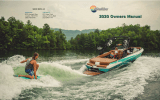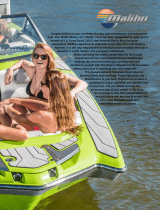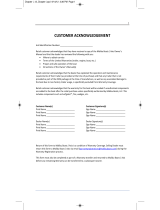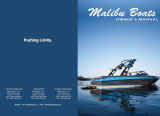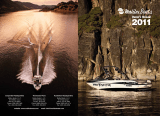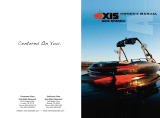Page is loading ...


Congratulations!
Congratulations on your purchase of a new, high-performance recreational tow boat. Your Malibu
Boats, LLC (“Malibu”) boat has been constructed to meet and/or exceed all U.S. Coast Guard
(USCG) and National Marine Manufacturers Association (NMMA) requirements applicable at the
time of its manufacture. However, it is still your responsibility as the boat owner to ensure the boat is
operated in a safe manner and is properly maintained.
Before operating this vessel, please take the time to get acquainted with the vessel and its various
features and controls. We recommend that you carefully read and familiarize yourself with this
Owner’s Manual and all on-product safety labels prior to operating your new watercraft.
Prior to operating the boat for the first time, you must carefully read and
familiarize yourself with this Owner’s Manual and all on-product safety labels. You
must also agree to comply with Federal, State and Local Boating Regulations.
This manual contains important information on Boating Safety, Boating Rules, Proper Operation
and Maintenance of your boat. This manual provides a guideline for proper operation and
maintenance of your boat, and you should consider it a permanent part of your vessel.
In the event that this boat is sold, this manual should be included along with the boat to ensure that it
will provide the same important information to the next owner.
Images and information utilized in this manual were the most up-to-date available at press time.
Because of Malibu’s commitment to continuous improvement, actual boats and components may vary
from those illustrated. Malibu does not guarantee the availability of what is shown herein.
Congratulations!


about this owner’s manual
The recommended practices and warnings in this manual represent sound advice for recreational boating and identify
common risks encountered by boaters engaging in towed watersport activities. Read and understand the contents of this
manual. Ask questions of a boating professional if anything in this manual does not make sense to you. The manual does
not cover all instances of risk or danger, so please use common sense and good judgment when boating. If you follow the
advice provided in this manual you will signicantly reduce risk to yourself, your passengers, towed participants, and other
boaters.
This manual is not intended to be a substitute for taking a course on boating safety nor is it a substitute for boating
experience. It is recommended that if you are unfamiliar with the use and operation of a boat you seek advice and training
from a qualied individual or organization. Check with your local marine law enforcement agency or dealer for more
information about boating safety classes in your area.
The precautions listed in this manual and on the boat are not all-inclusive. If a procedure or method is not specically
recommended, YOU must be satised that it is safe for you and your passengers, and that the boat will not be damaged
or made unsafe as a result of your decision. Remember – always use caution and common sense when operating and
maintaining your boat!

about your new boat
Malibu is proud to provide you with the most exciting, cutting-edge technology available in the towing-boat
industry. The boat you have purchased represents the state of the art at the time of manufacture. As you may
expect from the industry’s leader since 1982, Malibu expands and innovates continually. As a result, updated
product or specications may be introduced during any given model year. Malibu reserves the right to introduce
new product or changes to existing model lines without notication or incurring responsibility to make the same
changes to boats in the market completed prior to the date of change.
This Owner’s Manual has been compiled to address as many potential issues and questions as may arise in
addition to explaining how to operate the boat and its systems correctly and safely as possible to ensure long-
term and enjoyable use. However, Malibu cannot anticipate every potential situation that can arise, affecting
the care and protection of your boat, nor every circumstance that could arise in the operation or care of the
boat when not in use. Malibu strongly recommends reading any and all additional information provided by
component manufacturers’ and supplied with the boat at time of purchase. Also check out websites for Malibu
and its component manufacturers periodically to stay abreast of any changes, updates, service bulletins and
general information. Malibu will use these various methods of communication, from this Owner’s Manual and
including, but not limited to, direct mail contact and website updates, to make every reasonable effort to apprise
you of the information you will need to continue long-term and highly satisfactory use of your boat.


2019 Malibu Boats, LLC Owner’s Manual
Table of Contents
SAFETY
Embracing Safety .................................................................................................................................................................................4
Signal Words and Symbols Used in This Manual ................................................................................................................................ 4
Basic Safety Rules ..............................................................................................................................................................................4
Pre-Operation Check List–Before Leaving the Dock ...........................................................................................................................4
Precautions While Underway ..............................................................................................................................................................5
Safety While Maintaining the Vessel ...................................................................................................................................................7
Owner Responsibility and Boating Education ................................................................................................................................... 8
Important Safety Information ...............................................................................................................................................................8
Responsibilities of Boat Owner and Operators .................................................................................................................................... 8
Registration .........................................................................................................................................................................................9
Insurance ............................................................................................................................................................................................. 9
Boating Safety Education Opportunities .............................................................................................................................................. 9
Operation by Minors and Licensing ...................................................................................................................................................10
Navigation Lights ...............................................................................................................................................................................10
Emergency Safety Stop Switch .........................................................................................................................................................10
Personal Flotation Devices ................................................................................................................................................................11
Fire Extinguisher ................................................................................................................................................................................12
Horn or Whistle .................................................................................................................................................................................. 12
Bilge Pump(s) ....................................................................................................................................................................................12
Visual Distress Signals ......................................................................................................................................................................12
Recommended Safety Equipment .....................................................................................................................................................12
General Boating Safety Topics .......................................................................................................................................................... 13
Safe Speed ........................................................................................................................................................................................ 13
Passenger Safety ..............................................................................................................................................................................13
Carbon Monoxide Safety ...................................................................................................................................................................13
Proper Loading ..................................................................................................................................................................................15
Weighting Your Boat During Watersport Activities .............................................................................................................................15
Visibility of the Operator ....................................................................................................................................................................16
Boating Under the Inuence ..............................................................................................................................................................16
Product Misuse .................................................................................................................................................................................. 17
Reporting Accidents ...........................................................................................................................................................................17
Rendering Assistance ........................................................................................................................................................................ 17
Hazardous Conditions .......................................................................................................................................................................17
Environmental Concerns ...................................................................................................................................................................18
On Product Warning Labels ..............................................................................................................................................................19
Warning Labels and Locations ..........................................................................................................................................................19
Wakesetter Label Locations ..............................................................................................................................................................20
Response TXi Label Locations ..........................................................................................................................................................22
Basic Rules of the Road ......................................................................................................................................................................23
Boating Regulations ..........................................................................................................................................................................23
Encountering Another Vessel ............................................................................................................................................................23
Privileged Vessel ...............................................................................................................................................................................23

2019 Malibu Boats, LLC Owner’s Manual
Burdened Vessel ...............................................................................................................................................................................23
Crossing ............................................................................................................................................................................................23
Meeting Head-On ..............................................................................................................................................................................24
Overtaking .........................................................................................................................................................................................24
The General Prudential Rule .............................................................................................................................................................24
Other Rules of the Road .................................................................................................................................................................... 24
Aids to Navigation .............................................................................................................................................................................. 24
Night Running ..................................................................................................................................................................................... 26
Watersports Safety .............................................................................................................................................................................28
Hand Signals .....................................................................................................................................................................................28
Towed Person Safety Responsibilities ...............................................................................................................................................29
Additional Precautions for Towed Skier/Rider ....................................................................................................................................29
Tow Line Guidelines ..........................................................................................................................................................................31
Fallen Skier or Rider ..........................................................................................................................................................................31
Develop Water Sense ........................................................................................................................................................................ 31
Emergency Procedures .....................................................................................................................................................................33
Explosion and Fire ............................................................................................................................................................................. 33
Swamping and Flooding ....................................................................................................................................................................34
Capsizing ........................................................................................................................................................................................... 34
Staying Aoat .....................................................................................................................................................................................34
Collisions ...........................................................................................................................................................................................34
Grounding .......................................................................................................................................................................................... 34
Person Overboard .............................................................................................................................................................................34
Drowning ...........................................................................................................................................................................................35
Medical Emergency ...........................................................................................................................................................................35
Operation Failure ............................................................................................................................................................................... 35
Towing ...............................................................................................................................................................................................35
QUICK REFERENCE GUIDE
Response TXi .......................................................................................................................................................................................38
20VTX ...................................................................................................................................................................................................40
21MLX ..................................................................................................................................................................................................42
21VLX ................................................................................................................................................................................................... 44
22LSV ................................................................................................................................................................................................... 46
23LSV ................................................................................................................................................................................................... 48
25LSV ................................................................................................................................................................................................... 50
22MXZ ..................................................................................................................................................................................................52
24MXZ ..................................................................................................................................................................................................54
M235 .....................................................................................................................................................................................................56
Recommended Seating ........................................................................................................................................................................58
DASHES & VIDEO SCREENS
Wakesetter Command Center............................................................................................................................................................62
Engine Starting Code ........................................................................................................................................................................62

2019 Malibu Boats, LLC Owner’s Manual
Text/Phone Alert ................................................................................................................................................................................62
System Overview ...............................................................................................................................................................................62
Save Preset Button ............................................................................................................................................................................63
Four Corner Buttons ..........................................................................................................................................................................63
Depth Screen .....................................................................................................................................................................................63
Ballast Screen ...................................................................................................................................................................................63
Wake View ......................................................................................................................................................................................... 64
Speed Control ....................................................................................................................................................................................64
Surf Gate Control ...............................................................................................................................................................................64
Power Wedge Control .......................................................................................................................................................................65
Preset Screen .................................................................................................................................................................................... 66
Media Screen ....................................................................................................................................................................................66
Stereo Screen ....................................................................................................................................................................................67
Controls Screen ................................................................................................................................................................................. 68
Advanced Lighting Controls ............................................................................................................................................................... 68
Settings Screen .................................................................................................................................................................................69
Maps Screen .....................................................................................................................................................................................72
TXi Standard Gauges and Screen .....................................................................................................................................................75
Gauges ..............................................................................................................................................................................................75
Keypad ..............................................................................................................................................................................................75
Center Screen ...................................................................................................................................................................................75
Cruise Screen .................................................................................................................................................................................... 75
Engine Screen ...................................................................................................................................................................................76
Depth Screen .....................................................................................................................................................................................76
Alerts ..................................................................................................................................................................................................76
Lights Menu .......................................................................................................................................................................................76
Controls Menu ...................................................................................................................................................................................76
Settings Menu ....................................................................................................................................................................................76
Video Screens (Optional Malibu Open Edition) .................................................................................................................................77
Engine Start Code .............................................................................................................................................................................77
Gauge View and Speed Control ........................................................................................................................................................78
Night Mode ........................................................................................................................................................................................78
Speed Control Operation ................................................................................................................................................................... 78
Stereo Screen ....................................................................................................................................................................................78
Media Screen ....................................................................................................................................................................................79
PDF Viewer and Video Player ...........................................................................................................................................................79
Rear Camera .....................................................................................................................................................................................80
Controls Screen ................................................................................................................................................................................. 80
Settings Screen .................................................................................................................................................................................80
Maps Screen .....................................................................................................................................................................................82
3-in-1 Event Screen ............................................................................................................................................................................84
Care and Maintenance ......................................................................................................................................................................84
Navigation Features ..........................................................................................................................................................................84
GPS Information ................................................................................................................................................................................85
Zero Off GPS Speed Control .............................................................................................................................................................85
Three Event Information ....................................................................................................................................................................85
Slalom Settings ..................................................................................................................................................................................85
Buzzer Volume ..................................................................................................................................................................................85

2019 Malibu Boats, LLC Owner’s Manual
Timing Recap ....................................................................................................................................................................................86
Slalom Wait Time ...............................................................................................................................................................................86
Jump Settings .................................................................................................................................................................................... 86
Buzzer Volume ..................................................................................................................................................................................86
Timing Recap ....................................................................................................................................................................................86
Jump Switch ......................................................................................................................................................................................86
Jump Switch Timeout ........................................................................................................................................................................86
Trick Settings .....................................................................................................................................................................................86
Buzzer Volume ..................................................................................................................................................................................87
River Mode & Offset ..........................................................................................................................................................................87
Course Manager ................................................................................................................................................................................ 87
Auto Detect ........................................................................................................................................................................................87
Pull Type ............................................................................................................................................................................................ 88
Plus (+) Factor ...................................................................................................................................................................................88
Troubleshooting Guide ......................................................................................................................................................................88
Basic Electrical Components ............................................................................................................................................................89
Circuit Breakers .................................................................................................................................................................................89
Fuse Box ...........................................................................................................................................................................................89
Electrical Harnesses and Wiring ........................................................................................................................................................ 89
Batteries ............................................................................................................................................................................................89
Connecting/Disconnecting Batteries .................................................................................................................................................. 91
Battery Maintenance ..........................................................................................................................................................................92
Battery Charger .................................................................................................................................................................................92
Engine Sensors .................................................................................................................................................................................92
Other Electrical Components ............................................................................................................................................................93
12-Volt Receptacle ............................................................................................................................................................................83
Port Rear Breaker Board ...................................................................................................................................................................93
Surf Band ...........................................................................................................................................................................................93
Alarms ................................................................................................................................................................................................93
MALIBU MONSOON ENGINES, TRANSMISSIONS & V-DRIVES
Malibu Monsoon Engines, Transmissions & V-Drives .......................................................................................................................98
Safety ................................................................................................................................................................................................98
General Information ........................................................................................................................................................................... 99
California Emissions Information ...................................................................................................................................................100
General Emissions Information .......................................................................................................................................................101
Star Label ........................................................................................................................................................................................101
Additional Information, Including Warranty ......................................................................................................................................102
Malibu Fuel System .........................................................................................................................................................................102
Fuel Information ...............................................................................................................................................................................104
When the Boat Is Not in Operation (Fuel) .......................................................................................................................................104
Electrical System .............................................................................................................................................................................105
Alarms ..............................................................................................................................................................................................105
Cooling System ...............................................................................................................................................................................105
Exhaust System ...............................................................................................................................................................................107
Break-In Period—All Boats ..............................................................................................................................................................108
Vapor Lock .......................................................................................................................................................................................110

2019 Malibu Boats, LLC Owner’s Manual
Transmissions & V-Drives ...............................................................................................................................................................110
Transmissions ..................................................................................................................................................................................110
V-Drives ........................................................................................................................................................................................... 110
HOW IT WORKS
Safety First ........................................................................................................................................................................................ 114
Fire Extinguishing Equipment ..........................................................................................................................................................114
Emergency Engine Stop Switch ......................................................................................................................................................115
Lighting ............................................................................................................................................................................................ 115
Tie-Ups ............................................................................................................................................................................................117
Anchor Locker ..................................................................................................................................................................................118
Horn .................................................................................................................................................................................................118
Mirror ...............................................................................................................................................................................................118
Ladder .............................................................................................................................................................................................118
Fuel Fill ............................................................................................................................................................................................ 118
Interior Performance ........................................................................................................................................................................119
Steering Wheel ................................................................................................................................................................................ 119
Shifter/Throttle .................................................................................................................................................................................120
Electronic Throttle Control (ETC) ....................................................................................................................................................121
Pylon(s) ...........................................................................................................................................................................................121
Sports Dash ..................................................................................................................................................................................... 121
Rear and/or Dock Camera ............................................................................................................................................................... 122
Interior Luxury ..................................................................................................................................................................................122
Stereo Components .........................................................................................................................................................................122
Seating ............................................................................................................................................................................................122
Heated and/or Powered Driver’s Seat .............................................................................................................................................124
Armrests ..........................................................................................................................................................................................124
Glove Box ........................................................................................................................................................................................124
Storage Compartments ...................................................................................................................................................................125
Removable Cooler ........................................................................................................................................................................... 125
Cup Holders .....................................................................................................................................................................................126
Removable Trash Receptacle .........................................................................................................................................................126
Carpets and Mats ............................................................................................................................................................................126
Cockpit Table ...................................................................................................................................................................................126
Grab Handles ..................................................................................................................................................................................127
Heater .............................................................................................................................................................................................. 127
Tower, Canvas & Accessories .........................................................................................................................................................128
G3.5 Tower ......................................................................................................................................................................................128
GX Tower .........................................................................................................................................................................................129
Tower Accessories ...........................................................................................................................................................................130
Tower Lights ....................................................................................................................................................................................130
Bimini Top ........................................................................................................................................................................................130
G-Force Icon 8 Tower Speakers or G-Force Rev 8 Speakers with Horn .........................................................................................130
G3.5 PTM Clamping Spinner Board Racks or Ski Rack .................................................................................................................. 130
G3.5 Tower Mirror ............................................................................................................................................................................130

2019 Malibu Boats, LLC Owner’s Manual
On and Under the Water...................................................................................................................................................................131
Blower System .................................................................................................................................................................................131
Bilge System ....................................................................................................................................................................................132
Ballast System ................................................................................................................................................................................. 134
Power Wedge III ..............................................................................................................................................................................135
Surf Gate .........................................................................................................................................................................................136
Underwater Gear (Rudder, Fins, Strut, Propeller, Paddlewheel, Raw-Water Intake/Sea Strainer and Bow Thruster) ....................136
Shower ............................................................................................................................................................................................138
Swim Board and Ladders ................................................................................................................................................................139
Flush Kit ...........................................................................................................................................................................................139
Salt Water Series ............................................................................................................................................................................. 140
TRAILERS
Reporting Safety Defects .................................................................................................................................................................144
Legal Requirements for Towing .......................................................................................................................................................144
Basic Safety Rules ..........................................................................................................................................................................144
Connections to the Tow Vehicle ...................................................................................................................................................... 144
Preparation ......................................................................................................................................................................................144
Trailer Hitch .....................................................................................................................................................................................146
Safety Cables ..................................................................................................................................................................................146
Breakaway Cable ............................................................................................................................................................................147
Weight Distribution ..........................................................................................................................................................................147
How to Connect to the Tow Vehicle ................................................................................................................................................147
Attaching to the Tow Vehicle ............................................................................................................................................................ 147
To Open the Coupler .......................................................................................................................................................................148
To Close the Coupler .......................................................................................................................................................................148
Hitching Up ......................................................................................................................................................................................148
Connecting to the Boat ....................................................................................................................................................................148
Trailer Winch ....................................................................................................................................................................................148
Tie-Downs .......................................................................................................................................................................................149
Trailer Components and How They Function ................................................................................................................................150
Trailer Jack ......................................................................................................................................................................................150
Lights ...............................................................................................................................................................................................150
Axles ................................................................................................................................................................................................151
Wheels and Hubs ............................................................................................................................................................................151
Lug Nuts ..........................................................................................................................................................................................151
Tires ................................................................................................................................................................................................. 152
Brakes .............................................................................................................................................................................................152
Optional Storage Compartment .......................................................................................................................................................154
Towing Advice ...................................................................................................................................................................................155
Prior to Towing .................................................................................................................................................................................155
Pre-Tow Check List ..........................................................................................................................................................................155
Underway ........................................................................................................................................................................................155

Launching and Re-Loading the Boat from the Trailer ................................................................................................................... 156
When the Trailer Is Not in Use .........................................................................................................................................................156
GET READY
Get Ready .......................................................................................................................................................................................... 158
Malibu Fuel System .........................................................................................................................................................................158
Operations .........................................................................................................................................................................................161
Final Checks Before Starting ...........................................................................................................................................................161
Starting and Operation ....................................................................................................................................................................162
Starting the Engine–Wakesetters ....................................................................................................................................................162
To Turn Off–Wakesetters .................................................................................................................................................................162
Starting the Engine–Response ........................................................................................................................................................ 163
To Turn Off–Response ..................................................................................................................................................................... 163
Break-In Period–All Boats ...............................................................................................................................................................164
Smart Operations ............................................................................................................................................................................164
Stopping ..........................................................................................................................................................................................165
High Speed Maneuvers ...................................................................................................................................................................165
Special Conditions ........................................................................................................................................................................... 165
Towing and Interaction .....................................................................................................................................................................165
Anchoring .........................................................................................................................................................................................166
Docking and Tie-Up .........................................................................................................................................................................166
CARE & MAINTENANCE
On-Going Care ..................................................................................................................................................................................170
General Cleaning .............................................................................................................................................................................170
Canvas ............................................................................................................................................................................................170
Upholstery .......................................................................................................................................................................................172
Approved Cleaners for Malibu Upholstery .......................................................................................................................................173
Carpets and Mats ............................................................................................................................................................................175
Swim Board .....................................................................................................................................................................................175
Hull and Deck Finishes ....................................................................................................................................................................175
Stainless Steel, Chrome and Aluminum Components .....................................................................................................................175
Salt Water Series Care and Maintenance .......................................................................................................................................176
Routine Maintenance .......................................................................................................................................................................176
Before Starting the Engine ..............................................................................................................................................................177
After Starting the Engine ..................................................................................................................................................................177
After the Outing ................................................................................................................................................................................177
After 10 Hours on the Hourmeter ..................................................................................................................................................... 177
After 75 Hours or Annually ............................................................................................................................................................... 177
Storage and Winterization ...............................................................................................................................................................177
Routine Salt Water/Brackish Water Protection ................................................................................................................................177
Before Starting the Engine ..............................................................................................................................................................178
Check Coolant Level .......................................................................................................................................................................178
Inspect the Sea Strainer ..................................................................................................................................................................179
Check the Battery Holders and the Connections ............................................................................................................................. 179
Check for Odors ..............................................................................................................................................................................180
2019 Malibu Boats, LLC Owner’s Manual

2019 Malibu Boats, LLC Owner’s Manual
After Starting the Engine .................................................................................................................................................................181
Check for Odors, Particularly From Exhaust Emissions ..................................................................................................................181
Be Certain that the Battery Registers as Fully Charged and That There Is Sufcient Fuel for the Outing .....................................181
After the Outing ................................................................................................................................................................................181
Give the Engine Compartment a General Inspection ......................................................................................................................181
Check the Other Components .........................................................................................................................................................182
Note How Much Fuel and Battery Charge Were Used ....................................................................................................................182
Give the Boat a Good General Cleaning as Outlined in the On-Going Care Information that Precedes This Section ....................182
Salt Water/Brackish Water Extra Attention ......................................................................................................................................182
Flushing the Engine ......................................................................................................................................................................... 184
After 10 Hours on the Hourmeter ....................................................................................................................................................184
Have the Oil Changed by Your Authorized Malibu Dealer ...............................................................................................................184
Check the Safety Equipment ...........................................................................................................................................................185
After 75 Hours or Annually (whichever comes rst) .....................................................................................................................185
Engine Mounts .................................................................................................................................................................................185
Exhaust Flap ....................................................................................................................................................................................185
Steering System ..............................................................................................................................................................................185
Shift and Throttle System ................................................................................................................................................................186
Battery .............................................................................................................................................................................................186
Pumps .............................................................................................................................................................................................186
Coolant System ...............................................................................................................................................................................186
Oil System .......................................................................................................................................................................................187
Transmission/V-Drive System ..........................................................................................................................................................188
Fuel System .....................................................................................................................................................................................189
Hydraulic Steering Sytem ................................................................................................................................................................189
Check the Safety Equipment ...........................................................................................................................................................189
Power Wedge Manual Extension and Retraction ............................................................................................................................189
Salt Water Boats .............................................................................................................................................................................. 190
Storage and Winterization ...............................................................................................................................................................191
Hull Gel Coat ...................................................................................................................................................................................191
Extended Non-Use ..........................................................................................................................................................................191
Lifting the Boat .................................................................................................................................................................................191
Winterizing Boats Equipped with Optional Flush Kit ........................................................................................................................ 192
For Extended Storage Winterization ................................................................................................................................................ 193
WARRANTY
Malibu Boats, LLC Limited Warranty ..................................................................................................................................................196
Warranty Transfer ...............................................................................................................................................................................206
California and U.S. EPA Emission Control Warranty Statement .........................................................................................................207
Troubleshooting the Boat ................................................................................................................................................................209
Troubleshooting the Trailer .............................................................................................................................................................211
Service Log .......................................................................................................................................................................................212
Index ..................................................................................................................................................................................................214

s a f e t ys a f e t y


embracing safety
Signal Words and Symbols
Used In This Manual
Throughout this manual specic precautions and symbols
identify safety-related information. You will nd DANGER, CAUTION,
WARNING, NOTICE and SAFETY INSTRUCTIONS symbols which
require special attention. Please read them carefully and follow these
precautions as indicated! They will explain how to avoid hazards that
may endanger you, your passengers, towed participants, and other
boaters. PLEASE REVIEW ALL SAFETY INFORMATION.
DANGER indicates a
hazardous situation which,
if not avoided, will result in
death or serious injury.
WARNING indicates a
hazardous situation which,
if not avoided, could result
in death or serious injury.
CAUTION indicates a
hazardous situation which,
if not avoided, could result
in minor or moderate injury.
NOTICE is used to address
practices not related to
physical injury.
Safety instructions (or
equivalent) signs indicate
specific safety-related
instructions or procedures.
Basic Safety Rules
Make sure you understand all of the operating instructions prior
to attempting to operate this boat. Boating-related accidents are
generally caused by the operator’s failure to follow basic safety
rules or written precautions. Most accidents can be avoided if the
operator is completely familiar with the boat and its operation,
follows recommended practices, and is able to recognize and avoid
potentially hazardous situations.
Past accident data shows that most fatalities involve actions
which cause falls or ejections overboard, mishaps with towed persons,
propeller strikes, collisions, and carbon monoxide exposure. Past
accident data shows that most injuries are associated with collisions,
mishaps with towed persons, falls or ejections overboard, being
struck by the propeller, and res and explosions. These incidents are
mostly caused by operator inattention, operator inexperience, reckless
operation, alcohol/drug use, excessive speed, passenger or towed
person behavior, and violation of navigation rules.
Failure to observe the safety recommendations contained
in this manual may result in severe personal injury or death to
you or to others. Use caution and common sense when operating
your boat. Don’t take unnecessary chances! Basic safety rules are
outlined in this section of the manual.
Pre-operation Check List–
Before Leaving the Dock
Failure to follow these
precautions may result in
severe injury or death to you
and/or others.
The operator shall:
• Check that weather conditions are safe for boating. It is the
driver’s responsibility to determine if weather or other factors
have created an unsafe boating environment. Boaters must
continuously be aware of weather conditions. Sudden storms,
wind, water conditions, lightning, etc., can unexpectedly put
boaters in grave danger. Always check the local weather report
before going boating.
• Check that drain plugs are securely in place.
• Check bilge pump, horn, lights, blower and other equipment to
verify they are operating properly.
• Verify that the emergency cutoff switch lanyard is in proper
operating condition and is properly afxed to the driver.
• Check the operation of the steering system. Verify that the
steering is operational before launching the boat. If the boat is
already in the water, verify proper steering wheel operation at low
speed. Turn the steering wheel full stop in both directions and
2019 Malibu Boats, LLC Owner’s Manual • Page 4

2019 Malibu Boats, LLC Owner’s Manual • Page 5
verify proper rudder movement. Ensure that there is no binding or
stiffness in the steering wheel rotation. Binding and stiffness is an
indication that the steering needs repair. Failure of the steering
cable will result in loss of control of the boat.
• Ensure that the load of persons, ballast, and equipment is within
the limits stated on the USCG Maximum Capacities Plate and is
properly distributed based on instructions in this manual.
• Check that all safety equipment and life jackets, personal otation
devices (PFDs), and throwable cushions are in good condition
and suitable for your boat and passenger load.
• Inform all passengers where safety equipment is located and how
to use it.
• Have at least one other passenger who is capable of operating
the boat safely in case of an emergency.
GASOLINE VAPORS
CAN EXPLODE. BEFORE
STARTING ENGINE,
OPERATE BLOWER
FOR FOUR (4) MINUTES AND CHECK ENGINE
COMPARTMENT BILGE FOR GASOLINE VAPORS.
• It is very important to open the engine cover and check the
engine compartment and bilge for liquid gasoline and gasoline
vapors prior to each use of your boat and after refueling. Failure
to do so may result in re or explosion as well as serious injury or
death to you and/or others.
• If you see liquid gasoline in the engine compartments/bilge or
smell gasoline vapors, DO NOT attempt to start the engine.
Liquid gasoline in the bilge is an extreme re and explosion
hazard which may cause injury or death. Find and x the source
of the leakage, remove the liquid gasoline from the bilge. Then
ventilate the engine compartment/bilge and run the blower to
remove all gasoline vapors before starting the engine.
• If gasoline vapors persist after running the blower, DO NOT
attempt to start the engine. Likely, there is a gasoline leak that is
creating the excessive vapor.
• Always operate blower below cruising speed and after stopping
the boat.
Precautions While Underway
Failure to follow these
precautions will result in
serious injury or death.

2019 Malibu Boats, LLC Owner’s Manual • Page 6
The operator shall:
• Check that the area behind the boat is all clear before starting the
engine to AVOID PROPELLER INJURY to persons in the water
behind the boat or on the swim platform.
• Turn off the engine prior to anyone occupying the swim platform
or being in the water behind the boat to AVOID PROPELLER
INJURY. Being in neutral gear is insufcient; the propeller may
still be turning, or engine may be inadvertently shifted into gear.
• Not back the boat toward persons in the water behind the boat to
AVOID PROPELLER INJURY.
• Not allow people to be on or near the swim platform or in the
water near the swim platform while the engine is running because
CARBON MONOXIDE will exist around the back of the boat
when the engine is running. Engine exhaust contains carbon
monoxide, which is a deadly, odorless, colorless gas.
• Not operate the engine in a conned space or while tethered
to another vessel as CARBON MONOXIDE will be around the
boats.
• Not go under the boat cover with the engine running or
shortly after the engine has been running because CARBON
MONOXIDE may remain under the cover. Remove cover to
ventilate the area.
Failure to follow these
precautions may result in
severe injury or death to you
and/or others.
The operator shall:
• Follow safe operating practices, the “Rules of the Road,” and the
Watersports Responsibility Code.
• Not operate a boat if under the inuence of alcohol or other
drugs.

2019 Malibu Boats, LLC Owner’s Manual • Page 7
• Attach the emergency cutoff switch lanyard to the boat operator
when operating the boat.
• Maintain a proper course and safe speed at all times to avoid collisions.
• Maintain a lookout for other boats, swimmers and obstructions in
the water.
• Operate slowly in congested areas such as marinas and mooring areas.
• Keep a safe distance from other boats, swimmers, personal
watercraft, docks, and xed objects.
• Look before you turn/maneuver the boat so as to avoid potential
collisions with oncoming or overtaking vessels.
• Be aware that this boat is a high-performance boat and is
capable of quick, tight turns and changes in direction. Familiarize
yourself with the handling characteristics of the boat. It is the
operator’s responsibility to operate the boat in a manner that
ensures the safety of all passengers. Abrupt maneuvers may
result in the ejection of unsecured, unseated, or improperly
positioned passengers. Verbally warn passengers before making
quick, tight turns so they may have time to grasp a handrail,
hand-hold, or portion of the boat.
• Be aware that your boat will handle differently depending on
loading and on-board weight distribution.
• Ensure that all passengers are properly and securely seated in
appropriate seating locations to avoid falling or falling overboard.
• Instruct and ensure that passengers remain properly seated at all
times while the boat is in motion above idle speed.
• Not allow passengers to sit on the transom, seat backs, engine
cover or sides of the boat while the engine is running and the
boat is in motion to avoid falling overboard.
• Not allow passengers to sit in a position that obstructs the
operator’s view.
• NEVER leave children unattended and in the boat without adult
supervision.
• Have children riding in the bow of the boat be accompanied by an
adult in the bow and ensure that all remain seated when the boat
is in motion.
• Not let passengers occupy seats which may be in the path of the tow line.
• Slow down when crossing waves or wakes in order to
minimize the impact on passengers and the boat. Crossing
waves or wakes at an angle (such as 45 degrees) rather than
perpendicularly will reduce the severity of the impact. Avoid rough
water, large waves and large wakes from other boats when at
high speed. Jumping waves/wakes or slamming the bow will
cause large vertical impacts which may cause injury to occupants
or cause ejections.
• For safe towing (water skiing, tubing, wakeboarding, wake
surng, knee boarding, etc.) be experienced and have an
observer [an observer or “spotter” is required by law in most
states]. A rear view mirror is helpful if you are allowed to tow
without an observer in your state.
• Avoid letting tow lines or mooring lines wrap around anyone’s
body parts/limbs. Doing so could allow body parts/limbs to
become entangled in the line and could cause signicant injury,
such as amputations.
• Keep track of tow lines and dock lines so that they do not
become entangled in the propeller. A tow line will wrap quickly
around a spinning propeller and is capable of immobilizing the
boat and dragging a person entangled in the tow line underwater
or causing amputations. Shut off the engine if a tow line has
potential for wrapping in the propeller.
• The tower is designed to pull a single individual. Please consult
the remainder of this manual and/or warning labels on the tower
for details. DO NOT climb, sit on, stand on or jump/dive off of the
tower. Tow line may loop on inverted tricks. DO NOT sit behind
the pulling point of the tower.
• NEVER allow any type of spark or open ame on board. It may
result in re or explosion.
• Avoid grounding the boat: Be familiar with local conditions and
water depth. If you are uncertain, then proceed slowly with
caution. Sudden groundings from planing speeds may cause
rapid decelerations and cause occupants to impact the boat and/
or to be ejected from the boat. Boat damage may also occur.
• Always watch for low obstacles such as tree limbs, bridges or
power lines, especially in boats with tow towers.
• Seek shelter from open water if there is threat of lightning or
severe weather.
• NEVER dive from the boat without being absolutely sure of
the depth of the water. Severe injury or death may occur from
striking the bottom or submerged objects. Striking the bottom or
a submerged object while diving head rst can cause paralysis,
head injury or death.
• Provide assistance to other boaters in distress while ensuring the
safety of your own passengers.
• When you leave the boat, take the keys with you. This will keep
untrained and unauthorized persons from operating the boat.
(This will not be applicable on some keyless ignition systems.)
Safety While Maintaining the Vessel
Failure to follow these
precautions may result in
severe injury or death to you
and/or others.
The operator shall:
• Visually inspect the engine compartment and ventilate after
refueling.
• Inspect fuel system regularly. Examine fuel tanks, hoses and
/

